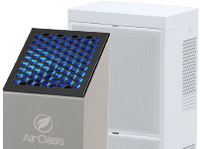UV Air Filtration and Purification
Health experts agree that one of the best ways to promote long-term health is to keep indoor air pure and free of both particulate contaminants as well as germs, bacteria, and other microbes. Today’s consumer is fortunate to have a wide variety of air purification systems to choose from, including air filters that more efficiently deal with microbial organisms than the air filters of years past. When it comes to choosing an air purifier and filtration system that will deal with these microscopic organisms, a filter that provides UV air purification may be the best choice to meet your needs.
Ultraviolet Air Cleansing: The Basics
Unlike other air filtration systems that depend on HEPA filters or other devices to trap dust and other particles, UV air filtration uses state-of-the-art ultraviolet light technology to keep viruses and other microorganisms from reproducing and infecting a home, office, or other indoor space. Ultraviolet light damages the genetic material that controls the reproduction of these organisms, making it impossible for them to reproduce. This stops these illness-inducing microbes in their tracks and prevents the spread of various diseases and other problems. An effective air purification system often combines UV lamp technology with a traditional filter in order to maximize both the removal of particulate matter from the air and the killing of germs and bacteria.
UV purification is most effective when the microorganisms have prolonged contact with the UV lamp. The longer that a virus or other organism is bathed in UV light, the greater the damage to its DNA and its ability to replicate itself. Furthermore, while UV air treatment can be useful in reducing the spread of viruses and other microbes, air purifiers with UV lights should be used in concert with other disease-prevention measures. Purifying air with ultraviolet light is no replacement for the regular disinfection that occurs when one cleans a home or office, but when used in concert with traditional cleaning methods, UV light purification can enhance any plan or system that is in place to reduce the spread of diseases.
The Air Oasis Difference
We stand behind our UV air filtration technology and believe that anyone can benefit from the use of ultraviolet filters to cleanse their air. Please contact us with any questions you may have about ultraviolet air purification or for more information on how our products can help your specific air cleaning needs.

